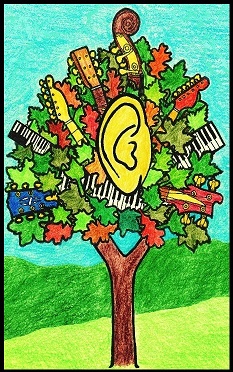 Go to: Teaching Beginners By Ear – Part 1
Go to: Teaching Beginners By Ear – Part 1
Guitar is a different story. On guitar, placing color-coded dots on the fretboard to mark simple open chord shapes greatly speeds up the process of learning chords and scales for beginners. Dots also make it easier for beginners to find locations higher up the neck, so they’re not limited to playing in open position.
With colored dots as markers, it takes only a few minutes for a first-time beginner to learn how to move his or her fingers in time with the chord changes of a simple, repetitive music track. Once they learn that, they’re in the groove. They learn to anticipate the chord changes, so I don’t have to tell them when to change.
By the end of the lesson, they can change chords in time with one or two simple songs or practice tracks. They have already established important muscle-memory patterns they will use every day of their lives as musicians. This is what a successful first lesson “by concept” on guitar or bass looks like. Later concepts will include rhythms, strum patterns, bass lines and melodies.
On bass, placing a few dots on the fretboard can make it easier for beginners to learn their first few songs. Temporarily placing one or two dots on the higher frets as landmarks for particular songs is often a big help for beginners. It’s a time-saver in the first few lessons, especially if you’re playing on the higher frets.
On piano, the process is basically the same, except that on piano it’s usually easier to start out with playing single-line melodies with one hand, and then the other, than it is to start with chords. Playing chords is a little stressful, and tires out your hands quickly, if you’re not used to them.
Beginning piano students usually need to build up their strength before they can play three-note chords comfortably. The easiest way to learn chords on the piano is to start with major and minor chords with white key roots. Start by alternating between triads that are right next to each other, like from F major to G major, or from C major to D minor. Alternate between your left and right hands. Don’t worry about playing chords in both hands together, at first.
Another useful routine is walking up and down the white keys in thirds. A “third” is two keys separated by one “empty” white key. A third is two thirds of a triad, a triad minus the lowest or highest note.
On guitar and piano, playing a chord progression in time is a very important basic skill. When a beginning student first gets the hang of this new skill, it’s a good idea to spend time consolidating and reinforcing it. Changing between two chords is a good way of introducing new chords, and building a basic chord vocabulary. As soon as you have just three or four chords, you can start playing with real songs.
You should spend time getting comfortable with a repertoire of simple songs, and portions of songs, based on just three or four chords. It takes practice to learn how to get in the groove with recorded music, so that you sound like you’re part of the band. That’s the main purpose of session training in a virtual band setting.
After ten lessons, many of my students can play along with twenty simple rock songs. That doesn’t mean they have mastered, or even fully learned twenty songs. It means they have a set of interactive routines which they can play in time with those songs. They are playing simplified versions of real parts from real songs, and they’re gradually closing in on the actual parts that were played in the original recordings.
After one hundred lessons, or two years, some of my students are already playing with other musicians in groups or jams. They can play dozens of complicated parts by that time. If you’ve read much rock biography, I don’t need to tell you what people have accomplished after really bearing down on non-classical guitar for two years.
Framework for beginners learning mechanics, reading and ear-training on guitar, piano or bass:
1) Start with the mechanics of playing chords and scales. Learn to make changes and play simple melodies with recordings. Apply this to practice tracks, and then to simple real songs.
2) Introduce note names. Learn where note names are located on the frets or keys. Start with a few at a time. This is easier on piano than guitar. On guitar, start by learning all the open strings, and the natural note names on each string in open position (up to the third fret).
3) Introduce staff notation. Use online flashcards and note identification apps. Start with a limited note range, and build out from there.
© 2019, 2020 Greg Varhaug